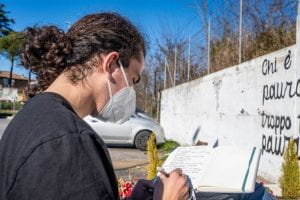
When I was first applying to the CRP department at Cornell, I decided to browse the Rome Workshop page of the website and looked down the list of neighborhood studies. I clicked on a random name that seemed nice to me: Acilia, situated between the city center and the Mediterranean Sea. The students had made artful renderings of the main piazza, collected detailed statistics, and spoken with neighborhood residents.
Now a reality for me, arriving in Rome has been a whirlwind — surreal to travel so far and suddenly see so many familiar Cornell faces (and many new) in such a remarkable but unfamiliar place. A city made up of hard the grandest of monuments and the most mundane of rituals such as getting coffee. It is hard not to be intrigued by everything or without millions of questions popping up in my head.
The Rome workshop pushes our URS cohort to venture far beyond the Rome that most know, immersing us in neighborhoods in both the center and the periphery. Rather than simply learn about Rome in a classroom, neighborhood studies set us out to explore the city on a 1:1 scale, making observations as we go and taking in everything. That is the first assignment. For our second assignment, our professors gave us a list of neighborhoods—all on the Roman periphery—to choose from, to make observations, and report back to class. Unsurprisingly, Acilia was my first pick. My roommate, Luke Slomba, and I were off the following Sunday on the Roma-Lido train line jotting down notes and sketching as much as we could in our matching notebooks wearing corduroy jackets bought from the same flea market. To the people around us, this was probably a funny scene.
So far, we have had the privilege to meet with scholars, artists, and organizers throughout Rome and Italy more broadly to look beyond the surface to see the different forces at play in Italian cities. Ultimately, the neighborhood study has probably been the most collaborative and generative project I have ever worked on. A deep dive into Quartiere Statuario, a neighborhood in Rome’s Southeastern periphery revealed that what at first and even second glance, appeared to be a typical suburb is a neighborhood with a rich history. We learned that today, Statuario is at the crossroads of contestation over its built and natural environment between outside political actors. While a lot of work, I am deeply thankful for the friendships I made and the dynamic we develop together as a team, to make work we can all share and be proud of.
This blog was reposted from the Cornell in Rome Blog.